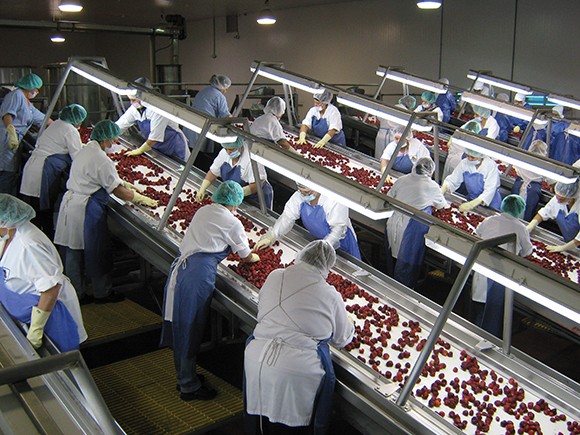Dry weather plagues Ventura County strawberries
IN THIS ARTICLE
- Agribusiness Topic
- Tom Bronzini Author
By Tom Bronzini Sunday, January 26th, 2014

Strawberries are sorted before being frozen at a packing plant in Oxnard. The fruit is the most valuable crop in the Tri-Counties. (courtesy photo by Cheryl Giacopuzzi, via the Museum of Ventura County’s Agriculture Museum)
Oxnard strawberry growers lost an average $10,000 to $15,000 per acre worth of crop last year because the berries died off prematurely in dry weather, and farmers could be in for a repeat of that scenario this year, a prominent Ventura County grower said at a strawberry symposium in Santa Paula on Jan. 25.
Edgar Terry, president of Terry Farms, told attendees at the county’s Agricultural Museum that Oxnard strawberries flamed out at the end of April last year and had to be turned under two months earlier than normal.
When Terry took questions from the audience, the Business Times asked about this year’s strawberries. “Right now the crop is fantastic,” he said. “It’s coming on strong, but that’s a problem. The crop can produce way too much early and use up all its energy and end up like last year when they died.” He said rain — the best irrigation — is needed to restore normalcy.
Terry and Ventura County Agricultural Commissioner Henry Gonzales spoke at the second in a series of strawberry symposia in connection with the museum’s current exhibition, “Strawberry Fields Forever?” Topics discussed were strawberry economics and the role of the agricultural commissioner.
Terry said plantings of strawberries are down by about 1,800 acres this year in Oxnard but up by 665 acres in Santa Maria, where the environment is cooler and farmers can grow the berries over a longer season.
“We’re hoping this year we don’t see the strawberries dying out because of the lack of rain,” Terry said. “When you have less rain you have more pests, more insects, dust is in the air. Dust causes all types of things. So because of that Oxnard has shrunken acres.”
In his presentation on strawberry economics, Terry laid out some figures that the public rarely gets to see on the substantial cost of growing strawberries in Ventura County. He presented a sample budget like real ones he has used at Terry Farms in Ventura County, where he is a fourth-generation farmer growing strawberries, celery and bell peppers on more than 1,400 acres.
He put the basic cost to grow strawberries at $18,285 per acre. Adding overhead such as fuel and office management, the cost rises to $23,762 per acre, not counting harvesting expenses. He put the total cost per acre before taxes to grow, pick and pack strawberries and haul them to a cooler at $42,372 per acre. Regulatory and compliance costs are hundreds of dollars per acre more. Terry estimated the net return per acre at $2,268 before taxes.
Terry called his presentation a philosophical discussion rather than an economics lecture. He said spending on agriculture as percentage of disposable income in the United States was 23.4 percent in 1929, at the start of the Great Depression, but was down to 10 percent in 2012.
While the public sees agriculture’s gross receipts going up every year in the county’s crop report, Terry said, “when you hold them constant to inflation, they are actually declining by .06 percent year over year.” Growers are surviving by boosting output per acre, he said.
Ventura County’s strawberry farmers are facing greater competition from Mexico, where production of the berry has gone up almost 100 percent in the last five years, Terry said. Strawberries are the county’s No. 1 crop, valued at $691 million in 2012.
Local consumers should be asking to pay more for the county’s produce if they don’t they want to see the food supply move offshore, he said.
Fumigation, drought at issue
Gonzales described the wide-ranging role of the county agricultural commissioner in detecting and eradicating pests, inspecting foods and seeds, auditing organic growers and certifying farmers’ markets, among other things. He spent considerable time explaining how his staff monitors and regulates fumigation of strawberry fields with methyl bromide, which is of particular concern to public safety.
He said there has been a 34 percent reduction in the acreage fumigated in Ventura County over the last three years as growers complied with limits under the Clean Air Act.
Gonzales said he has been concerned about protecting the safety of Mixtecos, indigenous people from Mexico who come to the county’s fields with no knowledge of Spanish or English. He hired a Mixteco student at Ventura College who learned both English and Spanish in the United States to be a translator, helping his office ensure that Mixtecos understand fumigation safety rules and that they can be understood when reporting chemical exposure or symptoms.
After Gonzales’ presentation, the Business Times asked him for his assessment of the drought. “It’s very dire and I’m hoping it will rain soon,” he said. “I’m really concerned that it’s not going to rain this year much, if at all.” He said he hopes that when people see the impact on the food supply and prices, “they will realize that we need to do something that will guarantee us, supply us, with the water that we need.”
He said that a federal declaration of a drought disaster that includes Ventura County will provide some help in the form of low-interest emergency loans to farmers, but that the relief is far from what is actually needed.
Consumers will feel the effect of the drought, he said. “This next year we’re going to see the prices of foods go up. No doubt,” he said.










